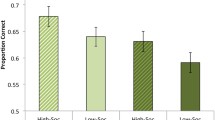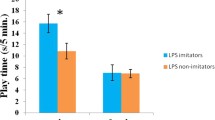Abstract
Primate species differ in their imitative performance, perhaps reflecting differences in imitative capacity. The developmentally earliest form of imitation in humans, neonatal imitation, occurs in early interactions with social partners, and may be a more accurate index of innate capacity than imitation of actions on objects, which requires more cognitive ability. This study assessed imitative capacity in five neonatal chimpanzees, within a narrow age range (7–15 days of age), by testing responses to facial and vocal actions with two different test paradigms (structured and communicative). Imitation of mouth opening was found in both paradigms. In the communicative paradigm, significant agreement was found between infant actions and demonstrations. Additionally, chimpanzees matched the sequence of three actions of the TC model, but only on the second demonstration. Newborn chimpanzees matched more modeled actions in the communicative test than in the structured paradigm. These performances of chimpanzees, at birth, are in agreement with the literature, supporting a conclusion that imitative capacity is not unique to the human species. Developmental histories must be more fully considered in the cross-species study of imitation, as there is a greater degree of innate imitative capacity than previously known. Socialization practices interact with innate and developing competencies to determine the outcome of imitation tests later in life.



Similar content being viewed by others
References
Abravenal E, Sigafoos AD (1984) Exploring the presence of imitation during early infancy. Child Dev 55:381–392
Anisfeld M (1996) Only tongue protrusion modeling is matched by neonates. Dev Rev 16:149–161
Bakeman R, Gottman J (1986) Observing interaction: an introduction to sequential analysis. Cambridge University Press, New York
Bard KA (1994) Evolutionary roots of intuitive parenting: maternal competence in chimpanzees. Early Dev Parent 3:19–28
Bard KA (1998) Social–experiential contributions to imitation and emotion in chimpanzees. In: Braten S (ed) Intersubjective communication and emotion in early ontogeny. Studies in emotion and social interaction, 2nd series. Cambridge University Press, New York, pp 208–227
Bard KA (2002) Primate parenting. In: Bornstein M (ed) Handbook of parenting, biology and ecology of parenting, vol 2, 2nd edn. Erlbaum, Mahwah, NJ, pp 99–140
Bard KA (2005) Emotions in chimpanzee infants: the value of a comparative developmental approach to understand the evolutionary bases of emotion. In: Nadel J, Muir D (eds) Emotional development. Oxford University Press, Oxford
Bard KA, Russell CL (1999) Evolutionary foundations of imitation: social cognitive and developmental aspects of imitative processes in non-human primates. In: Nadel J, Butterworth G (eds) Imitation in infancy. Cambridge studies in cognitive perceptual development. Cambridge University Press, New York, pp 89–123
Bard KA, Platzman KA, Lester BM, Suomi SJ (1992) Orientation to social and nonsocial stimuli in neonatal chimpanzees and humans. Infant Behav Dev 15(1):43–56
Bard KA, Fragaszy D, Visalberghi E (1995a) Acquisition and comprehension of a tool-using behaviour by young chimpanzees: effects of age and modeling. Int J Comp Psychol 8:47–68
Bard KA, Street E, McCrary C, Boothe R (1995b) The development of visual acuity in infant chimpanzees. Infant Behav Dev 18:225–232
Bard KA, Platzman KA, Lester BM, Suomi SJ (2001) Developpement neurobiologique et emotions chez les nouveau-nes chimpanzes et humains (Neurobehavioural integrity and emotions in chimpanzee and human neonates). Enfance 3:226–235
Bard KA, Myowa-Yamakoshi M, Tomonaga M, Tanaka M, Costall A, Matsuzawa T (2005) Group differences in the mutual gaze of chimpanzees (Pan troglodytes). Dev Psychol 41(4):616–624
Bard KA, Todd BK, Bernier C, Love J, Leavens DA (2006) Self-awareness in human and chimpanzee infants: what is measured and what is meant by the mark and mirror test. Infancy 9:191–219
Bjorklund DF (1987) A note on neonatal imitation. Dev Rev 7:86–92
Bjorklund DF, Bering J (2003) A note on the development of deferred imitation in enculturated juvenile chimpanzees (Pan troglodytes). Dev Rev 23:389–412
Brazelton TB, Nugent JK (1995) Neonatal behavioral assessment scale, 3rd edn. Mac Keith, London
Custance D, Bard KA (1994) The comparative and developmental study of self-recognition and imitation: the importance of social factors. In: Parker ST, Gibson KR, Boccia M (eds) Self-awareness in animals and humans: developmental perspectives. Cambridge University Press, New York, pp 207–226
Custance DM, Whiten A, Bard KA (1995) Can young chimpanzees (Pan troglodytes) imitate arbitrary actions? Hayes and Hayes (1952) revisited. Behaviour 132(11–12):837–859
Ferrari PF, Visalberghi E, Paukner A, Fogassi L, Ruggiero A, Suomi SJ (2006) Neonatal imitation in rhesus macaques. PLoS Biol 4:e302, DOI: 10.1371/journal.pbio.0040302
Field T, Woodson R, Greenberg R, Cohen D (1982) Discrimination and imitation of facial expression by neonates. Science 218:179–181
Fragaszy D, Bard KA (1997) Comparisons of development and life history in Pan and Cebus. Int J Primatol 18:683–701
Ger J, Bandman F, Couturier-Fagan D, Goldstein A, Hayut I, Sheiber F, Turkewitz G, Rose S, Anisfeld M (1994) Neonatal repsonses to the modeling of tongue protrusion and mouth opening. In: Paper presented at the International Conference on Infant Studies, 2–5 June 1994, Paris
Hallock MB, Worobey J, Self P (1989) Behavioral development in chimpanzees (Pan troglodytes) and human newborns across the first month of life. Int J Behav Dev 12:527–540
Heimann M (1991) Neonatal imitation: a social and biological phenomenon. In: Archer T, Hansen S (eds) Behavioral biology: neuroendocrine axis. Erlbaum, Hillsdale, NJ, pp 173–186
Heimann M, Nelson K, Schaller J (1989) Neonatal imitation of tongue protrusion and mouth opening: methodological aspects and evidence of early individual differences. Scand J Psychol 30:90–101
Heyes C (2001) Causes and consequences of imitation. Trends Cogn Sci 6:253–261
Jacobson SW (1979) Matching behavior in the young infant. Child Dev 50:425–430
Keller H, Scholmerich A, Eibl-Eiblesfeldt I (1988) Communication patterns in adult–infant interactions in western and non-western cultures. J Cross-Cult Psychol 19:427–445
Kugiumutzakis G (1999) Genesis and development of early infant mimesis to facial and vocal models. In: Nadel J, Butterworth G (eds) Imitation in infancy. Cambridge University Press, Cambridge, UK, pp 36–59
Legerstee M (1991) The role of person and object in eliciting early imitation. J Exp Child Psychol 51:423–433
Maratos O (1982) Trends in the development of imitation in early infancy. In: Bever TG (ed) Regressions in mental development: basic phenomena and theories. Erlbaum, Hillsdale, NJ, pp 81–101
Meltzoff A, Moore MK (1977) Imitation of facial and manual gestures by human neonates. Science 198:75–78
Meltzoff A, Moore MK (1989) Imitation in newborn infants: exploring the range of gestures imitated and the underlying mechanisms. Dev Psychol 25:954–962
Miklosi A (1999) The ethological analysis of imitation. Biol Rev 74:347–374
Myowa M (1996) Imitation of facial gestures by an infant chimpanzee. Primates 37:207–213
Myowa-Yamakoshi M (2006) How and when do chimpanzees acquire the ability to imate? In: Matsuzawa T, Tomonaga M, Tanaka M (eds) Cognitive development in chimpanzees. Springer, Berlin Heidelberg New York pp 214–232
Myowa-Yamakoshi M, Tomonaga M, Tanaka M, Matsuzawa T (2004) Imitation in neonatal chimpanzees (Pan troglodtyes). Dev Sci 7:437–442
Nadel J (2002). Imitation and imitation recognition: functional use in preverbal infants and nonverbal children with autism. In: Meltzoff A, Prinz W (eds) The imitative mind: development, evolution, and brain bases. Cambridge University Press, Cambridge, UK, pp 42–62
Nadel J, Butterworth G (1999) Imitation in infancy. Cambridge University Press, Cambridge, UK
Nagy E, Molnar P (2004) Homo imitans or homo provocans? The phenomenon of neonatal imitation. Infant Behav Dev 27:57–63
Papousek H, Papousek M (1987) Intuitive parenting: a dialectic counterpart to the infant’s integrative competence. In: Osofsky J (ed) Handbook of infant development, 2nd edn. Wiley, New York, pp 669–720
Piaget J (1962) Play, dreams and imitation in childhood. Norton, New York
Preston SD, de Waal FX (2002) Empathy: its ultimate and proximate bases. Behav Brain Sci 25:1–71
Rochat P (2001) Dialogical nature of cognition. Monogr Soc Res Child Dev 66(2):133–143
Russon AE, Galdikas B (1995) Constraints on great apes’ imitation: model and action selectivity in rehabilitant orangutan (Pongo pygmaeus) imitation. J Comp Psychol 109:5–17
Tomasello M, Savage-Rumbaugh ES, Kruger A (1993) Imitative learning of actions on objects by children, chimpanzees, and enculturated chimpanzees. Child Dev 64:1688–1705
Trevarthen C (1979) Communication and cooperation in early infancy: a descriptive of primary intersubjectivity. In: Bullowa M (ed) Before speech: the beginnings of interpersonal communication. Cambridge University Press, New York
Trevarthen C, Aitken KJ (2001) Infant intersubjectivity: research, theory, and clinical applications. J Child Psychol Psychiatry 42:3–48
Ullstadius E (1998) Neonatal imitation in a mother–infant setting. Early Dev Parent 7:1–8
van Lawick-Goodall J (1968) Behaviour of free-living chimpanzees of the Gombe Stream area. Anim Behav Monogr 1:163–311
Vinter A (1986) The role of movement in eliciting early imitations. Child Dev 57:66–71
Want SC, Harris PL (2002) How do children ape: applying concepts from the study of non-human primates to the developmental study of “imitation” in children. Dev Sci 5:1–41
Whiten A, Ham R (1992) On the nature and evolution of imitation in the animal kingdom: reappraisal of a century of research. In: Slater PJ, Rosenblatt J, Beer C, Milinski M (eds) Advances in the study of behaviour. Academic, New York, pp 239–283
Whiten A, Custance DM, Gomez JC, Teixidor P, Bard KA (1996) Imitative learning of artificial fruit processing in children (Homo sapiens) and chimpanzees (Pan troglodytes). J Comp Psychol 110(1):3–14
Acknowledgements
The research was supported by NIH Grants, RR-00165, RR-03951, and RR-01658. The Yerkes National Primate Research Center of Emory University is fully accredited by the American Association of Laboratory Animal Care. Grateful appreciation is extended to Kelly McDonald, Carolyn Fort, Josh Schneider, Kathy Gardner, Linda Brent, Dorothy Fragaszy, and, especially, Erica Yeager. I thank David Leavens and anonymous reviewers for critical comments that contributed to an improved manuscript.
Author information
Authors and Affiliations
Corresponding author
Rights and permissions
About this article
Cite this article
Bard, K.A. Neonatal imitation in chimpanzees (Pan troglodytes) tested with two paradigms. Anim Cogn 10, 233–242 (2007). https://doi.org/10.1007/s10071-006-0062-3
Received:
Revised:
Accepted:
Published:
Issue Date:
DOI: https://doi.org/10.1007/s10071-006-0062-3




